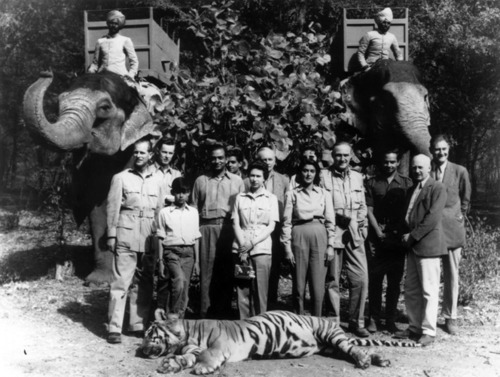Killing Tigers or Maneaters (as many of you would put it) is the symbol of grandeur, nobility and pride. Killing tigers has always been a passion for the Great kings, aristocrats and hunting enthusiasts. “The more you kill, the popular and fierce Ruler you become!” is what they all believed in!
A tradition ascending from the Mughals to the likes of Maharajahs, British Lords and Poachers, was a sever act of killing spree which .
~Royal Hunting Expedition & Genocide~
It all started during the time of Emperors who ruled majority of South Asia, primarily those who ruled over Indian Sub-continent. The Mughals were the primary starters of Royal Hunting (Sikar). Emperor Babur killed for pleasure, so did Akbar the Great and his heirs, and later Maharajas and British Generals. It was a symbol of royalty and pride; a method of proving manliness and socio-economic strength. Killing 100s of tiger in a day was next to none for them when they were done killing more than 1000 animals in a single hunting expedition.
British Raj, the ultimate successor of Mughal empire and the makers of Modern India, chose hunting to dominate their local peers. Killing tigers was not just a prideful enjoyment but a point worth proving to Indian monarchs and locales.
The Rajputs accompanied by British lords and generals killed 100s of tiger in a day. De-skinning the remains and showing off was the ultimate purpose of this great royal game.
~Poaching Tigers for Medicinal Purposes and Smuggling~
China is the biggest importers of poached Tiger parts. They primarily use it to prepare ancient medicines. Some elites prefer keeping tiger skin or bones at their home as a symbol of nobility.
WWF’s Initiative
97% of tiger population has been lost during the turn of 20th Century and till now. Many of the species has totally disappeared, namely; Bali Tiger, Javan Tiger, Caspian Tiger and South China Tiger, followed by many which are in the state of extinction.
Today, estimated total of 3,200 tigers survive in the wild. The endemic course of human-tiger conflict, poaching and habitat loss and fragmentation has caused the population to dramatically decrease from 40,000 to 3,200 in just mere 43 years.
In Nov 2010, leaders of the tiger range governments met in St. Petersburg, Russia and agreed on the goal to double the number of wild tigers by 2022. They presented the global tiger recovery program which represents the plan and commitments by the countries to achieve this laudable goal.
Download WWF’s Infographic on Tiger Facts







